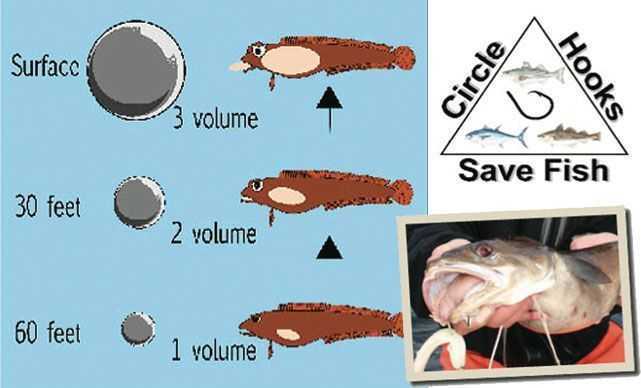Have you ever hooked a fish, reeled it to the surface, and gone to release it, only to watch the fish simply float away? You may have just witnessed the effects of barotrauma.
Many fish have an organ called a swimbladder, a small, gas-filled sac that aides fish in controlling buoyancy. The organ works by holding a volume of air, keeping the fish neutrally buoyant underwater. This means that the fish doesn’t have to do extra work to keep from either sinking or floating to the surface. The fish can (very slowly) adjust the level of air as it swims into deeper or shallower water. However, the sudden change of depth that occurs when being hooked and subsequently reeled to the surface, coupled with the drastic temperature change between the ocean floor and the surface, can cause the air in their swimbladder to expand at a rate that the fish can’t adjust for. The expanding air has to find a place to go. Depending on the species of fish, the swim bladder may expand to a large size, displacing internal organs. It may also rupture, sending gas into the body cavity, eyes, or muscle tissue. When this occurs, it is called barotrauma.
Neither of these scenarios is particularly good for the health of the fish. However, if the fish is of legal size and the angler wants to take it home to eat,then it is not a big deal. On the other hand, if the fish is of sub-legal size or is not a desired species for the angler to retain, it will be released. When released, the barotrauma-inflicted fish is not able to swim downward and is left to float on the surface of the water. This is a problem. If we as anglers want all – or at least most – of our released fish to live to grow bigger, than we have to figure out how to combat barotrauma.
On the West coast and in the Gulf of Mexico, recreational anglers have found ways to offset barotrauma. Since 2008, anglers fishing in the Gulf of Mexico have been required to possess and use a “venting tool” to deflate the swimbladders of Gulf reef fish when fishing in state waters. These “tools” are simply hollow needles that are inserted through the body-wall of the fish and into the over-inflated swimbladder, thus allowing the gas to escape before the fish is returned to the water. Although effective at removing the extra air from the swimbladder, venting tools can injure internal organs and potentially introduce infection through the hole created while venting and so their use is becoming less recommended.
An alternative to venting tools is a method used on the West Coast which involves using “release devices” to return fish to the water. If a fish with barotrauma can return to a comfortable depth, the gas may dissipate naturally, and the fish can regain normalcy. The devices work by transporting fish exhibiting symptoms of barotrauma from the surface back to the depth at which they were hooked. There are several different devices on the market ranging in price from $6 to $50. Most of the devices can be used on a fishing rod and have a weight that pulls the fish back down while holding onto the mouth area. They work in several different ways with one needing the weight to contact the sea-floor which releases the grip on the fish’s lip, another device is pressure sensitive and releases the fish once the desired depth is reached, and another is essentially a reverse hook that requires a slight tug on the line to allow the fish to slide off. Another type of release device can be made at home using nothing more than a milk crate, lead weights, and piece of rope. The milk crate is inverted on top of the fish and lowered by hand to the desired depth before being pulled up, leaving the fish behind.
In the Northwest Atlantic, barotrauma has not been closely studied as it relates to recreational release mortality of fish. However, MarineFisheries, with a grant from West Marine, has begun to examine barotrauma. Focusing on Gulf of Maine groundfish showing symptoms of barotrauma, MarineFisheries is examining the physical and behavioral responses of fish that are released using commercially available release devices. The main goal is to find ways to have released fish survive thus reducing unwanted and unnecessary mortality. The results from the study will be used to design more species-specific projects examining the long term effects of barotrauma on important recreational species and educate recreational anglers about the existence, availability, and use of release devices. Check mass.gov/marinefisheries and our twitter account (@MassDMF) for updates on this study.
